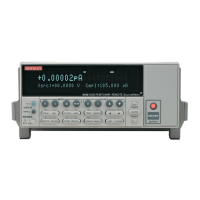Ohms Measurements 4-5
3. Select measurement range.
Use the RANGE
▲ and ▼ keys to select a range appropriate for the expected ohms
reading, or use autorange by pressing AUTO. When using manual ranging, selecting the
most sensitive (lowest) range provides the best accuracy. Autorange automatically goes
to the most sensitive range.
4. Turn output on.
Turn the output on by pressing the ON/OFF OUTPUT key. The OUTPUT indicator will
turn on to indicate the output is on.
5. Observe reading on display.
The SourceMeter will go into compliance if you exceed the maximum ohms measure-
ment range.
6. Turn output off.
When finished, turn the output off by pressing the ON/OFF OUTPUT key. The
OUTPUT indicator light will turn off.
Manual ohms measurements
Perform the following steps to perform manual ohms measurements.
NOTE The following procedure assumes that the SourceMeter is already connected to the
DUT as explained in Section 2.
WARNING To prevent electric shock, do not make or break connections to the Source-
Meter with the output on. If on, press the ON/OFF OUTPUT key to turn
the output off.
1. Select ohms measurement function.
Press MEAS Ω to select the ohms measurement function.
2. Select manual ohms measurement method.
• Press CONFIG then Ω.
• Select SOURCE, then press ENTER.
• Select MANUAL, then press ENTER.
• Press EXIT to return to normal display.
3. Configure source.
For manual ohms, you can Source I or Source V at the user-programmed output level.
The lowest allowable compliance limit is based on the load and the source value. For
example, if sourcing 1V to a 1kΩ resistor, the lowest allowable current compliance is
1mA (1V/1kΩ = 1mA). Setting a limit lower than 1mA will place the source in compli-
ance. Refer to steps 1 and 2 of Section 3, Basic source-measure procedure to configure
the source.
NOTE Use the V-Source for manual ohms measurements when high-speed settling is
required (i.e., production testing).

